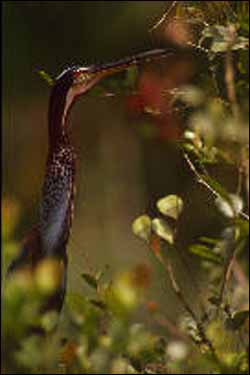The largest colony of Agami Herons found in French Guiana

©IRD/Reynaud, Pierre <br>Légende : Héron agami : curiosité. Marais de Kaw, Guyane. Référence Indigo : 18981
The Agami Heron has a height of just 70 cm. It can be distinguished from other herons especially by its predominantly chocolate-coloured plumage and its very long beak (2). The bird is described as solitary, grouping together only in the reproductive period, in small colonies. They are sometimes associated with other bird species The Agami heron is observed in Central and South America. However, its rarity and discreet behaviour mean that little is known about its biology or ecological status. It is a diurnal species. Some of its characteristics, like the length of its beak, its downy plumage or its partly nocturnal activity, place it in a separate genus (Agamia), within the family Ardeidae.
In May 2002, an IRD research team (1) conducting a scientific expedition to the Kaw Swamp in French Guiana, discovered an exceptionally extensive colony of Agami Herons, numbering about 900 nests. It is the largest nesting site ever seen for these birds.
The colony is located at the heart of the Guianan nature reserve, 40 km south-east of Cayenne, in an area surrounded by open water. Access can be gained only by helicopter. The site is hidden on a vegetation-covered bar and in deep shade overtopped by palm species. This reproduction area is also the gathering ground for several other marsh bird species, like the hoatzin and the anhinga, or snake bird, with some rare Ardeidae:the Cocoi Heron and the Great Egret. Heron nests were examined. A study was also made of both nocturnal and daytime behaviour of adult birds within or outside the colony. This work led to an estimate of 1800 individuals, representing 900 couples and as many nests. These are fixed on bushes and trees at a level of a little over two metres above water and measure about 15 cm in diameter and are built to 8 cm high. The Agami Herons breed asynchronously, in that they do not all lay their eggs at the same time of the season. Consequently, these nests hold young at different stages of development: eggs, chicks or juveniles already able to fly. Thick foliage protects them from the sun.
During the day the adults do not venture outside the colony and the chicks are not fed. The latter, however, receive their food during the night. Considerable movements of the adult herons have been observed between nightfall and midnight. The frequency of returns to the colony, established at 180 per half-hour over four or five hours, suggests that these birds go to fishing grounds distant from the colony, but always towards the North. The solitary nature of Agami Herons implies that they could return to the “hunting” areas they usually frequent during the rest of the year. These areas are made up of swamp and savannah, extending over about 1000 km². Their estimated flight speed is at least 35 km/h, so the herons travel up to 100 km, at night, to bring food to their offspring. Their night vision is not so well developed as strictly nocturnal species, therefore on their return they pick out their nest by using particular contact calls as signals exchanged with their mate who stays in the colony, or with their chicks.
There must be an explanation for such a concentration of Agami Herons. Although bird assembly behaviour at reproduction time is well known, large colonies are rare in French Guiana. This site, where several bird species are grouped together, is the most extensive one of the East of the territory. Yet the waters of the Kaw Swamp do not appear to hold enough fish to meet the nutritional needs of all the birds present in such a limited surface area. Moreover, they harbour black caymans, capable of capturing the herons on watch perched on the branches at water surface level. The advantage of the habitat seems rather to lie in its general security. The area is inaccessible owing to the density of the vegetation, water level variations and the presence of black caymans, and is hence remote from human settlements, in the nature reserve, and therefore protected from possible disturbance.
The observations made provided new information on the biology and behaviour of this hitherto little-known heron. Data concern in particular the criteria it uses for choosing reproduction grounds (size of the trees that are to support nests, shade, presence of water and so on). However, certain characteristics specific to the Agami Heron, such as the adaptation to nocturnal activity, remain to be elucidated. Research and study of other nesting sites over the whole distribution zone of this species should help ensure its protection and allow accurate evaluation of its ecological status.
Media Contact
All latest news from the category: Ecology, The Environment and Conservation
This complex theme deals primarily with interactions between organisms and the environmental factors that impact them, but to a greater extent between individual inanimate environmental factors.
innovations-report offers informative reports and articles on topics such as climate protection, landscape conservation, ecological systems, wildlife and nature parks and ecosystem efficiency and balance.
Newest articles

NASA: Mystery of life’s handedness deepens
The mystery of why life uses molecules with specific orientations has deepened with a NASA-funded discovery that RNA — a key molecule thought to have potentially held the instructions for…

What are the effects of historic lithium mining on water quality?
Study reveals low levels of common contaminants but high levels of other elements in waters associated with an abandoned lithium mine. Lithium ore and mining waste from a historic lithium…

Quantum-inspired design boosts efficiency of heat-to-electricity conversion
Rice engineers take unconventional route to improving thermophotovoltaic systems. Researchers at Rice University have found a new way to improve a key element of thermophotovoltaic (TPV) systems, which convert heat…



